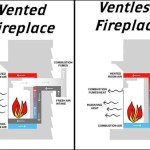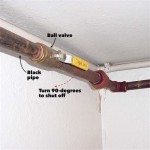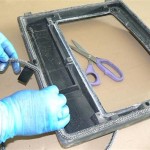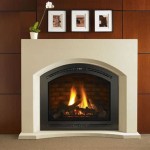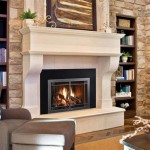Here's an article on gas fireplace inserts, tailored to your specifications:
Gas Fireplace Insert Reviews: A Comprehensive Guide
Gas fireplace inserts represent a significant upgrade for homeowners seeking the aesthetic appeal of a traditional fireplace with enhanced efficiency and convenience. Unlike open-hearth fireplaces, which often lose a significant portion of heat up the chimney, gas inserts are designed to provide substantial supplemental heating while maintaining realistic flame appearances. This article will delve into the key aspects of gas fireplace inserts, offering a detailed review of their functionality, features, and selection criteria, ensuring informed decision-making for potential buyers.
A gas fireplace insert is essentially a self-contained heating unit that fits directly into an existing masonry or prefabricated fireplace opening. They operate by burning natural gas or propane, producing heat that is then circulated into the room. Most models are equipped with a sealed combustion system, which draws air from outside the home for combustion and vents exhaust gases directly outdoors, minimizing drafts and improving indoor air quality compared to traditional fireplaces. Efficiency ratings for gas inserts are typically much higher than those of open fireplaces, often exceeding 70% or even 80% for newer models. This means a greater percentage of the fuel consumed translates directly into usable heat within the home.
Understanding the Key Features and Benefits
When evaluating gas fireplace inserts, it is crucial to consider several key features and benefits. These factors will influence the overall performance, convenience, and aesthetic appeal of the unit. Understanding these aspects will help in selecting an insert that best meets individual needs and preferences.
Heating Capacity and Efficiency: The heating capacity of a gas fireplace insert is measured in British Thermal Units (BTUs). Determining the appropriate BTU output relies on the size of the space to be heated. A larger room necessitates a higher BTU rating. It’s important to consider the room's insulation, window placement, and overall climate. Over-sizing can lead to overheating, while under-sizing will fail to adequately warm the space. Efficiency, measured as Annual Fuel Utilization Efficiency (AFUE), indicates how effectively the insert converts fuel into usable heat. Higher AFUE ratings translate into lower fuel consumption and reduced heating costs. Look for Energy Star-certified models for optimal efficiency.
Venting Options: Gas fireplace inserts require venting to safely exhaust combustion gases. There are typically two main venting options: direct vent and B-vent. Direct vent systems draw air from outside and exhaust gases directly outside through a sealed system, offering superior efficiency and safety. B-vent systems utilize the existing chimney for venting. Direct vent systems provide greater flexibility in terms of installation location compared to B-vent systems, which depend on the existing chimney structure. However, B-vent systems can sometimes be a more cost-effective option if an existing chimney is already in good condition.
Aesthetic Appeal and Design Options: Gas fireplace inserts are available in a wide range of styles and finishes to complement various home decors. Options include traditional log sets, contemporary glass media, and various firebox liners. The realism of the flame is influenced by the burner design and the quality of the log set or media. Some models include features such as adjustable flame height, ember beds, and accent lighting to enhance the visual appeal. The firebox liner, which is the material lining the interior of the fireplace, can also significantly affect the overall look. Common liner materials include brick, porcelain, and metal. Considering the desired aesthetic and the existing décor is crucial in selecting an insert that seamlessly integrates into the home.
Evaluating Different Types of Gas Fireplace Inserts
Gas fireplace inserts are broadly categorized based on their venting configuration and fuel type. Understanding these distinctions aids in selecting the appropriate type for a specific installation and application.
Natural Gas vs. Propane: Most gas fireplace inserts are designed to operate on either natural gas or propane. Natural gas is generally more cost-effective in areas where it is readily available, as it is typically supplied through a municipal pipeline. Propane, on the other hand, requires storage in a tank, which can be either above-ground or underground. Propane offers greater flexibility in terms of location, as it does not depend on a gas line. The decision between natural gas and propane depends on fuel availability, cost, and personal preferences.
Direct Vent Inserts: Direct vent gas fireplace inserts are the most common type due to their efficiency and safety. These inserts draw combustion air from outside and vent exhaust gases directly outside through a coaxial or co-linear venting system. The sealed combustion chamber prevents indoor air from being used for combustion, minimizing drafts and improving indoor air quality. Direct vent systems are generally more expensive to install than B-vent systems, but they offer superior performance and safety. They are also more versatile in terms of installation location, as they do not rely on an existing chimney.
B-Vent Inserts: B-vent gas fireplace inserts utilize the existing chimney for venting. These inserts are typically less expensive to install than direct vent models, but they are also less efficient and may not be suitable for all installations. B-vent systems rely on natural draft to vent exhaust gases, which can be affected by factors such as chimney height, outside temperature, and wind conditions. Before installing a B-vent insert, it is essential to have the chimney inspected to ensure it is in good condition and meets the safety requirements. B-vent inserts are best suited for homes with existing, well-maintained chimneys and where efficiency is not the primary concern.
Important Considerations Before Purchasing
Prior to purchasing a gas fireplace insert, several crucial factors should be considered to ensure a successful installation and satisfactory performance. These factors include accurate measurements, professional installation, and local code compliance.
Accurate Measurements and Sizing: Precise measurements of the existing fireplace opening are essential to ensure proper fit. The insert must be sized appropriately to fit within the firebox while allowing for adequate clearance for venting and proper operation. Measure the width, height, and depth of the fireplace opening, as well as the dimensions of the firebox. Consult with a qualified installer to determine the appropriate size and BTU output for the insert based on the dimensions of the space to be heated and the home's insulation characteristics. Incorrect sizing can lead to inefficient heating, safety hazards, and potential damage to the insert or the surrounding structure.
Professional Installation: While some homeowners may be tempted to install a gas fireplace insert themselves, it is strongly recommended to hire a qualified professional. Gas fireplace inserts involve gas lines, venting, and electrical connections, which require specialized knowledge and skills to install safely and correctly. Professional installers will ensure that the insert is properly vented, connected to the gas line, and that all safety features are functioning correctly. Improper installation can lead to gas leaks, carbon monoxide poisoning, and other serious safety hazards. Furthermore, professional installation often comes with a warranty that protects against defects in workmanship.
Compliance with Local Codes and Regulations: Before installing a gas fireplace insert, it is essential to check local building codes and regulations. Many municipalities have specific requirements for gas fireplace installations, including venting requirements, gas line specifications, and electrical codes. Failure to comply with local codes can result in fines, delays, and potential safety hazards. Obtain the necessary permits before starting the installation process, and ensure that the installer is familiar with local codes and regulations. A qualified installer can guide you through the permitting process and ensure that the installation meets all applicable requirements.
Choosing the right gas fireplace insert necessitates careful consideration of various performance and features. The factors outlined in this article, including heating capacity, venting options, aesthetic appeal, fuel type, and installation considerations, will ensure that homeowners can make well-informed decisions. This leads to a safe, efficient, and aesthetically pleasing addition to their homes.
.aspx?strip=all)
Top 11 Gas Fireplace Insert Trends Of 2024

Reviews For Pleasant Hearth Universal Circulating Zero Clearance 32 In Ventless Dual Fuel Fireplace Insert Pg 1 The Home Depot

Chaska 34 Gas Fireplace Insert Kozy Heat

Best Gas Fireplace Inserts Fireplaces Direct Learning Center

Reviews For Duluth Forge Dual Fuel Ventless Gas Fireplace Insert 32 000 Btu T Stat Control Model Fdf400t Zc Pg 1 The Home Depot

Best Gas Fireplace Insert Top 5 For Existing Fireplaces

Kingsman Clean View Gas Fireplace Insert Review Fireplaces Direct Learning Center

Enviro The E30 Gas Fireplace Insert Toronto Home Comfort

Enviro S Gas E33 Insert

Enviro S Gas E30 Insert
Related Posts


